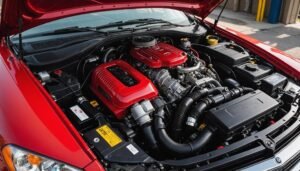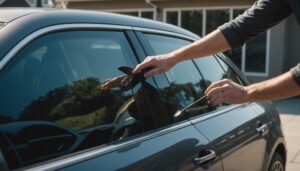Did you know that charging an electric car can take anywhere from a few hours to several days, depending on your charging method? Understanding the differences between Level 1, Level 2, and DC Fast Charging can help you avoid unexpected delays. Factors like battery capacity and environmental conditions also play an essential role. So, what should you know to guarantee you’re never left stranded? Let’s explore the intricacies of electric vehicle charging.You can learn more about how-fast-do-nascar-cars-go
Key Takeaways
- Level 1 Charging adds 2 to 5 miles of range per hour, typically requiring the longest time for a full charge.
- Level 2 Charging provides 10 to 60 miles of range per hour, allowing a full recharge in a few hours based on battery size.
- DC Fast Charging can recharge up to 80% in around 30 minutes, making it ideal for quick stops during long trips.
- Charging times can vary significantly based on vehicle model, state of charge, temperature, and home wiring capabilities.
- Planning charging stops effectively can help minimize downtime during travels and improve overall trip experience.
Understanding Electric Vehicle Charging Types

When it comes to charging your electric vehicle (EV), understanding the different charging types is crucial; each option affects how long you’ll need to wait for a full charge. The three main types of charging are Level 1, Level 2, and DC Fast Charging.
Level 1 charging uses a standard household outlet, providing a slow charge, often adding about 2 to 5 miles of range per hour. This method’s best for overnight charging at home.
Level 1 charging offers a slow charge via a regular outlet, perfect for overnight home charging.
On the other hand, Level 2 charging stations are more powerful, delivering 10 to 60 miles of range per hour, making them suitable for home installations or public charging stations.
Finally, DC Fast Charging is the quickest option, enabling you to recharge up to 80% in just 30 minutes, perfect for road trips. Knowing these types helps you plan effectively and guarantees you get the range you need when you need it.You can learn how-to-get-cigarette-smell-out-of-car
Level 1 Charging: Home Convenience

Level 1 charging brings the convenience of home charging right to your doorstep. Utilizing a standard 120-volt outlet, this method is ideal for those who don’t need to power up quickly. You simply plug your electric vehicle into a regular wall socket, making it super easy and accessible. While it generally delivers around 4 to 5 miles of range per hour, it’s perfect for overnight charging. Most drivers find that they can easily replenish their battery while they sleep, waking up to a full charge each morning.
Installing a Level 1 setup requires minimal effort, as no special equipment is needed, thereby saving you installation costs. However, if you’re constantly on the move or have a longer daily commute, you may want to evaluate your charging needs. Level 1 charging is simply about balancing convenience with your lifestyle, providing a hassle-free option for electric vehicle owners.You can learn how-long-does-it-take-to-charge-a-car-battery
Level 2 Charging: Faster Solutions

If you’re looking for a quicker charging solution, Level 2 charging is the way to go. This option considerably reduces your electric car’s charging time, allowing you to get back on the road faster. With a Level 2 charger, you can expect to fully recharge your vehicle in just a few hours, depending on the battery size and charger output.
- Feel the freedom of extended road trips without worry.
- Enjoy the convenience of faster charging at home.
- Save precious time during busy days.
- Experience peace of mind with reliable performance.
- Embrace the technological upgrade that enhances everyday life.
Investing in a Level 2 charger can transform how you manage your electric vehicle’s power needs. With efficient charging, you’re not just saving time; you’re enhancing your driving experience and sustainability journey every day.
DC Fast Charging: Quick Top-Ups on the Go
For those who need a quick power boost while on the road, DC fast charging offers an ideal solution that minimizes downtime. These chargers deliver high
Factors Affecting Charging Times
When considering how long it takes to charge your electric car, several factors come into play that can greatly impact charging times. Understanding these will help you plan better and avoid frustrations.
- Charger Type: The speed of charging varies drastically between Level 1, Level 2, and DC Fast Chargers.
- Current State of Charge: If your battery’s low, it may take longer to reach full capacity than if it’s just partially depleted.
- Battery Temperature: Extreme temperatures can affect charging efficiency—heat can slow it down, while cold can hinder it.
- Vehicle Model: Different cars have varying charging capabilities and requirements, which you’ll need to account for.
- Home Wiring: Your home’s electrical system and its capability to deliver power can impede or enable quicker charging.
Battery Capacity and Its Impact on Charging
Battery capacity plays an essential role in determining how long it takes to charge your electric vehicle, as larger batteries generally require more time to replenish than smaller ones. For instance, a vehicle with a 60 kWh battery might take considerably less time to charge compared to one with a 100 kWh battery, especially using standard home chargers.
Charging speed isn’t just about capacity; it’s also influenced by the charging station’s output. Fast chargers can drastically reduce charging time, regardless of battery size. However, keep in mind that charging a bigger battery at full speed continuously could lead to thermal management issues, affecting efficiency.
You need to take into account your driving habits too. If you mainly drive short distances, a vehicle with a smaller battery might suit you just fine, balancing both charging time and practicality. Understanding these dynamics helps you make an informed choice tailored to your needs.
Environmental Conditions and Charging Efficiency
While you might not think about it, environmental conditions can greatly impact the efficiency of charging your electric car. Factors like temperature, humidity, and even altitude play significant roles in how quickly your vehicle’s battery charges.
Consider these emotional triggers:
- Extreme heat can lead to battery degradation.
- Cold weather slows chemical reactions in the battery.
- High humidity can cause electrical issues.
- Altitude changes can reduce charging effectiveness.
- Wind can affect the performance of charging stations.
Each of these conditions can hamper your charging experience, leaving you frustrated and inconvenienced. Understanding how the environment impacts charging speed can help you plan accordingly, ensuring your electric vehicle is ready when you need it most. By being mindful of these factors, you’ll maximize your driving experience and reduce anxiety related to unexpected charging delays.
Tips for Efficient Charging
Taking environmental factors into account, enhancing your electric car charging process can greatly improve efficiency. First, always charge during off-peak hours. This not only lowers your electricity bill but also reduces strain on the grid. Next, verify your vehicle’s battery is at the appropriate temperature; a cooler battery charges more efficiently. If it’s colder than 32°F (0°C), consider using preconditioning to warm it up.
Using a Level 2 charger whenever possible is essential for faster charging, as it delivers noticeably more power than a standard outlet. Additionally, avoid frequent quick charges unless necessary, as they can decrease battery lifespan.
Lastly, keep your car’s software updated for ideal performance and efficiency. By following these tips, you can make your electric vehicle charging less time-consuming and more eco-friendly, all while maximizing your driving range for each trip.
Planning Your Charging Strategy for Road Trips
As you plan your road trip, it’s crucial to develop a charging strategy that guarantees you have access to power when you need it. A little foresight can keep your adventure smooth and enjoyable. Here are some key elements to evaluate:
Planning your road trip requires a solid charging strategy to ensure a smooth and enjoyable journey.
- Identify charging stations: Map out charging locations along your route to avoid surprises.
- Check charging speeds: Not all stations are equal; understanding charging times helps you plan breaks effectively.
- Have a backup plan: Outages can occur, so know alternative stations nearby in case your pick is unavailable.
- Stay updated: Use apps to monitor station availability in real-time, ensuring you won’t face long waits.
- Factor in downtime: Use charging time for meals, restroom breaks, or sightseeing to maximize efficiency.
When equipped with a solid strategy, you’ll explore with confidence, embracing the journey rather than worrying about power—making your electric road trip memorable and hassle-free.
Frequently Asked Questions
Can I Charge My Electric Car in Cold Weather?
Sure, you can charge your electric car in cold weather—just as you can try to keep ice cream solid in a heatwave. The efficiency of the battery drops in lower temperatures, which means it may take longer to charge. Keep your car plugged in to maintain ideal battery temperature and consider using a heated garage if possible. Embrace the winter chill, but know it might slow your charging game a bit!
Do Different Electric Car Models Charge at Different Speeds?
Yes, different electric car models charge at different speeds. Factors like battery size, charging technology, and maximum charging rates affect how quickly they can replenish energy. For instance, some vehicles support faster DC fast charging, while others may only charge slowly with standard AC outlets. You’ll want to check your car’s specifications and charging capabilities to understand how quickly it can charge under various conditions. This knowledge helps you plan your trips effectively.
Is It Safe to Charge Overnight at Home?
Yes, it’s generally safe to charge your electric car overnight at home, as long as you use a proper charging station. Most modern electric vehicles are equipped with safety features that prevent overheating and overcharging. Just make certain your electrical system is up to code and can handle the load. It’s a convenient way to guarantee your vehicle’s ready to go each morning, maximizing efficiency while providing peace of mind.
How Can I Find Nearby Charging Stations Quickly?
To find nearby charging stations quickly, you can use mobile apps like PlugShare or ChargePoint. These apps provide real-time information on station locations, availability, and types of chargers. Google Maps also has a feature to search for charging stations, just enter “charging stationsin the search bar. Additionally, your car’s navigation system might include charging station options, helping you plan your route efficiently while you’re on the go.
Does Charging at 100% Reduce Battery Lifespan?
Charging your electric vehicle to 100% is like filling a balloon to its limit; eventually, it strains and may burst. Yes, consistently charging to full can reduce your battery’s lifespan. Lithium-ion batteries thrive on partial charges, ideally staying between 20% and 80%. By avoiding the edges of the battery’s capacity, you maximize its longevity and performance. So, consider charging to a lower percentage to keep your battery happy and healthy for longer.













